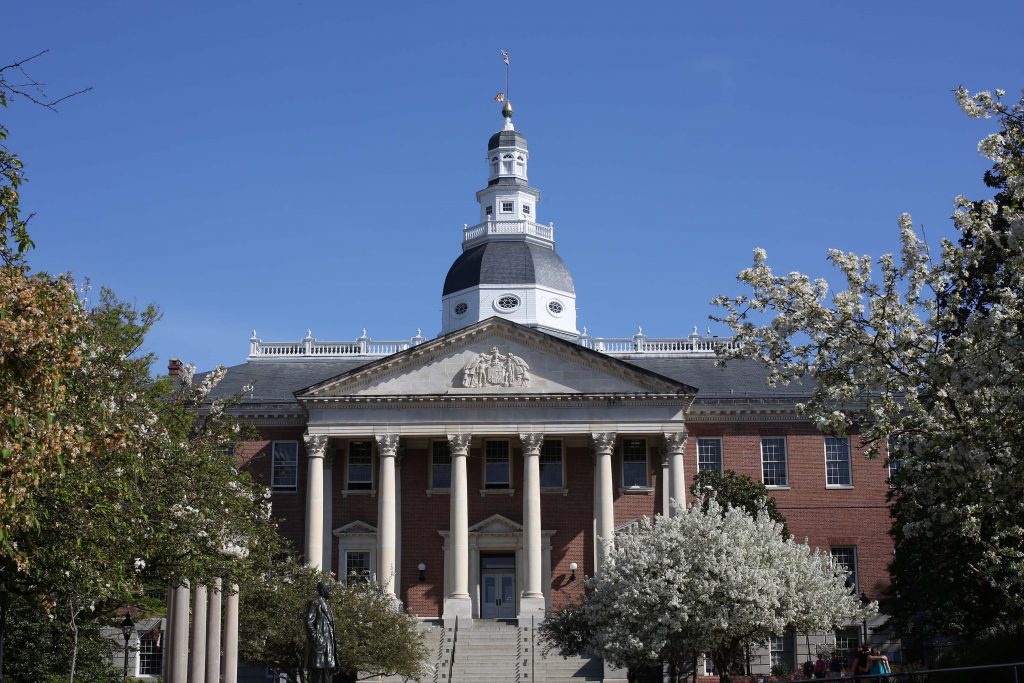New U.S. congressional maps from Maryland’s redistricting groups could impact incumbents and voters by drawing districts that don’t include the homes of their current representatives.
The Maryland Citizens Redistricting Commission proposed a map which would draw two districts where no current incumbents live.
The citizens commission voted to approve the congressional map in a meeting Wednesday.
The vote was 8-1, with member William Thomas one of the commission’s three Democratic members, dissenting.
Earlier this year, Gov. Larry Hogan, R, directed the citizen commission to submit a map to him.
Hogan would then likely prepare and submit a map to the Legislature, where it would be considered alongside a map from the Legislative Redistricting Advisory Commission.
The legislative commission map is expected to have more traction in the heavily Democratic Legislature, though its draft maps have not yet been released.
The final proposed map from the citizens commission includes a Western Maryland district that follows the state’s northern border rather than the southwest one.
Rep. David Trone, D-Potomac, represents Western Maryland and does not live in either the current or proposed version of his district.
Federal law requires that members of Congress live in the state they represent but not necessarily the district.
The new map would also create a district made up primarily of Anne Arundel and Howard counties.
The current congressional map breaks both counties up among multiple districts.
Rep. John Sarbanes, D-Baltimore, who represents the closest current analog to the new district, does not live within the proposed new district lines.
No current Maryland representatives live in the proposed Anne Arundel and Howard district.
On the other hand, two current representatives, Rep. Jamie Raskin, D-Takoma Park, and Rep. Anthony Brown, D-Mitchellville, both live in a proposed district that includes the northern portion of Prince George’s County and part of western Montgomery County.
Brown announced last week he will run for attorney general and not seek reelection to Congress.
Sarbanes and Rep. Dutch Ruppersberger, D-Cockeysville, both live within the confines of a proposed district for Northern Baltimore County.
Maryland’s current congressional representatives live in two main clusters around the Washington and Baltimore metropolitan areas.
While Maryland’s maps are gerrymandered, the clusters may be a symptom of population distribution, according to Helen Brewer, a legal analyst for non-partisan Princeton Gerrymandering Project.
“Since urban areas are generally more populous, it is common to see more numerous, geographically smaller districts in urban areas and bigger districts that have to span larger but less densely populated areas of land in more rural areas,” Brewer wrote in an email to Capital News Service.
The gerrymandering project analyzes redistricting maps and grades them on partisan fairness, competitiveness, and geographic features.
Brewer said the grades do not take where incumbents live into account.
“The people of Maryland are the best experts on their own state, though, so if they see problems with the maps, whether related to incumbent protection or other issues, they should make their voices heard and submit public comments on the maps,” Brewer wrote.
In an executive order establishing the citizen commission, Gov. Larry Hogan, R, directed the commission not to consider where incumbents live when drawing maps.
Seven of Maryland’s eight congressional representatives are Democrats.
As of October 2020, 55% of Maryland voters were registered as Democrats, just under 25% were registered as Republicans and around 18% were unaffiliated.
Maryland’s other redistricting group, the Legislative Redistricting Advisory Commission, has a majority Democratic membership, like the General Assembly powering the commission.
The legislative commission said they plan to release draft maps later this month.
Todd Eberly, an associate professor of political science and public policy at St. Mary’s College of Maryland, said the “pressure is to create a map that doesn’t hurt Democrats in any way, but doesn’t look like this.”
Eberly said map drawers are aware of Maryland’s reputation for gerrymandering, but making a better map without hurting Democrats is difficult.
“That’s going to be tough because of where incumbents live,” Eberly said.
In addition to drawing districts that include incumbents, Eberly thinks Democrats may want to protect the partisan balance of districts so incumbents don’t have to run in tighter races.
The legislative commission might have motivation to protect incumbents in their maps, but in a similar process after the 2010 census, there weren’t open discussions about it.
That’s according to James King, a former Republican delegate from Anne Arundel County.
“I think that would have been inappropriate,” King said. “It was a very professional commission.”
However, King also noted that “any elected official has self interest in creating a district that’s favorable to them,” and that “what took place behind the scenes obviously, I have no idea.”
Senate President Bill Ferguson, D-Baltimore, Speaker Adrienne Jones, D-Baltimore County, Del. Eric Luedtke, D-Montgomery, Del. Jason Buckel, R-Allegany, and commission Chair Karl Aro — all members of the legislative commission — did not respond to requests for comment.
Sen. Melony Griffith, D-Prince George’s, declined to comment because the redistricting process is ongoing.
Sen. Bryan Simonaire, R-Anne Arundel, said he thinks incumbents should be part of a group of considerations.
“Look at … geographic layout of the district, try to keep communities together,” Simonaire said. “But to completely ignore current representatives, I don’t think is wise.”
In September, a Virginia state lawmaker drew criticism for drawing a proposed map to protect his own seat, according to reporting from the Richmond Times-Dispatch.
The legislative commission is scheduled to meet Wednesday in Columbia and were also planning a meeting Friday evening.

